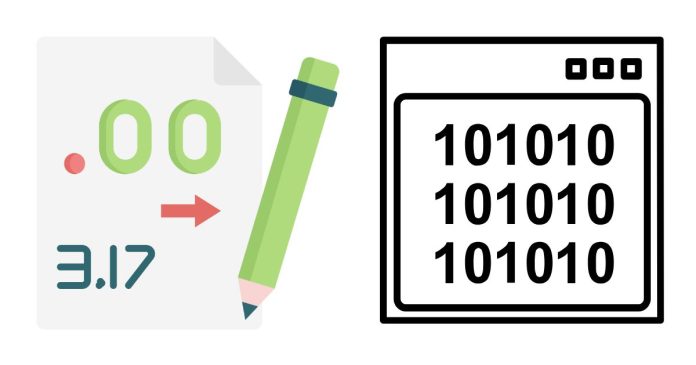The decimal and binary number systems are both ways of representing numbers, but they differ in the base they use, how they operate, and where they are applied. Below are the key differences between the two:
1. Base System
- Decimal Number System (Base 10):
- The decimal system is based on 10 digits: 0, 1, 2, 3, 4, 5, 6, 7, 8, 9.
- It is the most commonly used number system for everyday counting and arithmetic.
- Binary Number System (Base 2):
- The binary system is based on 2 digits: 0 and 1.
- It is primarily used in computers and digital systems, where information is represented in the form of binary states (on/off, true/false).
2. Digits Used
- Decimal: The digits range from 0 to 9. Each position in a decimal number represents a power of 10.
Example: 12341234 in decimal is 1×103+2×102+3×101+4×1001 \times 10^3 + 2 \times 10^2 + 3 \times 10^1 + 4 \times 10^0.
- Binary: The digits are restricted to 0 and 1. Each position in a binary number represents a power of 2.
Example: 10111011 in binary is 1×23+0×22+1×21+1×20=8+0+2+1=111 \times 2^3 + 0 \times 2^2 + 1 \times 2^1 + 1 \times 2^0 = 8 + 0 + 2 + 1 = 11 in decimal.
3. Number Representation
- Decimal:
- The decimal system can represent larger numbers using fewer digits compared to binary.
- For example, the number 255 in decimal is just three digits, whereas in binary, it would be represented as 1111111111111111 (8 digits).
- Binary:
- The binary system requires more digits to represent large numbers. Every increase in magnitude requires a doubling of the number of digits.
Example:
- Decimal 10 = Binary 1010 (4 digits)
- Decimal 255 = Binary 11111111 (8 digits)
4. Mathematical Operations
- Decimal:
- Arithmetic operations like addition, subtraction, multiplication, and division are easier to perform in the decimal system because we are more familiar with it.
- Binary:
- Binary arithmetic is fundamental in computing. Operations like addition, subtraction, multiplication, and division are also possible in binary, but they require different techniques, such as carrying over in binary addition or using shifts for multiplication/division.
5. Usage in Technology
- Decimal:
- Used for general-purpose calculations, financial transactions, measurements, and in daily life.
- Binary:
- Binary is the backbone of computer science, used in the internal representation of data in all modern computers and digital systems. Computers use binary because electronic circuits can easily represent two states: on (1) and off (0).
6. Conversion
- Decimal to Binary: To convert a decimal number to binary, you repeatedly divide the decimal number by 2, noting the remainders. The binary number is the sequence of remainders read from bottom to top.
Example: Convert 1313 to binary:
13÷2=6 remainder 113 \div 2 = 6 \text{ remainder } 1 6÷2=3 remainder 06 \div 2 = 3 \text{ remainder } 0 3÷2=1 remainder 13 \div 2 = 1 \text{ remainder } 1 1÷2=0 remainder 11 \div 2 = 0 \text{ remainder } 1The binary equivalent of 13 is 11011101.
- Binary to Decimal: To convert a binary number to decimal, you multiply each binary digit (bit) by the corresponding power of 2 and sum the results.
Example: Convert 11011101 (binary) to decimal:
1×23+1×22+0×21+1×20=8+4+0+1=131 \times 2^3 + 1 \times 2^2 + 0 \times 2^1 + 1 \times 2^0 = 8 + 4 + 0 + 1 = 13
7. Efficiency
- Decimal: Easier for humans to understand and work with due to its widespread use in everyday life.
- Binary: More efficient for computer systems as it directly correlates with the binary states (high voltage for 1 and low voltage for 0) of digital circuits.
Summary of Differences
| Feature | Decimal (Base 10) | Binary (Base 2) |
|---|---|---|
| Digits | 0, 1, 2, 3, 4, 5, 6, 7, 8, 9 | 0, 1 |
| Base | 10 | 2 |
| Used For | Everyday counting, financial systems | Computers, digital electronics |
| Number Representation | Shorter numbers | Longer numbers |
| Mathematical Operations | Easy for humans | Used in computing systems |
| Conversion | Easy conversion to/from binary | Fundamental in computing |
| Efficiency | Human-friendly | System-efficient for electronics |
Conclusion
While the decimal system is used in daily life for human-based calculations and understanding, the binary system is the foundational language of computers and digital technology. Binary’s simplicity with two digits makes it ideal for use in electronics, where states are represented as on/off or true/false.


